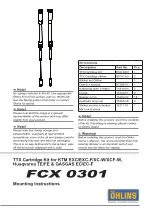
Eaton’s Crouse-Hinds Business
Cooper Crouse-Hinds Pte Ltd
No. 2 Serangoon North Ave 5 #06-01
Singapore 554911
tel: + 65 6645 9888
fax: +65 6297 4819
Page 16
Advantage:
The limit values can be set to best match the actual values of this particular segment
and device. As segments all differ in length, number of devices, and environmental
impact, this procedure will allow the user to set limits as close as possible to the actual
values and make most use of predictive alarming. Compared to the manual
procedure, running wizards is more convenient and faster.
Disadvantage:
The values in the device will differ from the values in the DCS engineering station,
unless an upload from the device into the engineering station is performed.
Otherwise, a later download from the engineering station would overwrite the values
in the device.
Also, the values may differ between one run and the next, as they depend on the
status quo of the segment.
Note that for the alarm optimization wizards to complete successfully, the low-low-
limits and high-high-limits should ideally be set to their defaults prior to running the
wizard.
For details on configuration of a specific node type, see sections 6 (system node), 7 (segment
node) and 8 (device node).
5.2.
When the DTM is brought from offline to online, it performs an automatic upload. This is
different from manual uploading, because it updates the device data set (i.e. the parameter
values in the F809F module) and instance data set with the
s data, but keeps
unchanged the working data set (the parameter values that the user is currently working with).
Note: Manual uploading will synchronize both the instance data set and the working data set
from the F809F device data set. If a "downloading" job is in progress then both manual and
automatic uploading commands will be ignored.
A download will download the working data set into the F809F module.
















































